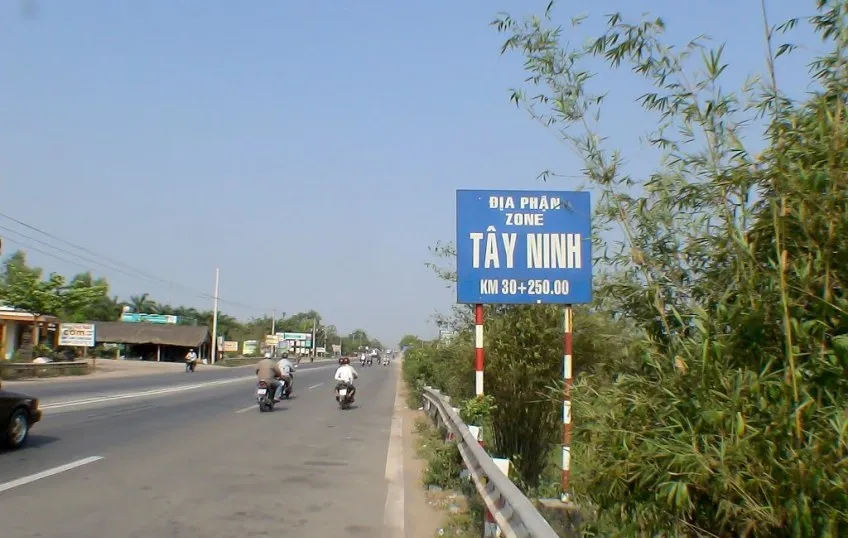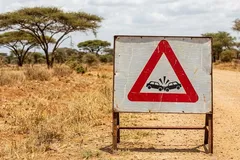
The province has not yet fully promoted its role as a gateway for international trade through the Trans-Asia axis that connects with other regions in ASEAN region through the Moc Bai and Xa Mat gateways.
Traffic congestion
Many of those who travel regularly on Highway 22 that crosses through Ho Chi Minh City and Tay Ninh province are most likely overwhelmed with the heavy traffic congestion. Along the 20 km stretch in Hoc Mon district, and the approximately 7 km section through Trang Bang Industrial Park, the road is perpetually jammed with all forms of vehicles, from container lorries, trucks, and smaller vans, making travel time longer and causing extreme environmental pollution. Due to the rapid increase in vehicular traffic in recent years, it can take three to four hours to cover a distance of 120 kms from Tay Ninh city to the center of Ho Chi Minh City.
This serious congestion on Highway 22 has affected opportunities to attract investments to Tay Ninh province, especially high-tech industries that produce electronic components for exports to other countries through ports in Ho Chi Minh City. At the same time, traffic congestion also affects tourists every weekend, especially those who visit the special national relic area of the Central Department of the South in Tan Bien district, close to the border with Cambodia, about 180 km from Ho Chi Minh City.
It is not just domestic tourists from Ho Chi Minh City and the Eastern and Southwestern provinces visiting Tay Ninh province that are affected, but also those who are travelling from Thailand and Cambodia through the Xuyen A or Trans-Asia axis, making it difficult for travel companies to exploit cross-border and inter-regional tours of the Southeast and Southwest regions. One travel business in Ho Chi Minh City said that five years ago, three days’ tour from Ho Chi Minh City to Cambodia on the weekend attracted many domestic tourists, but recently, the number of tourists has decreased due to the effects of the pandemic and a tedious time consuming journey.
Boost for whole region
The entire province of Tay Ninh currently has 8,282 kms of roadways, including 8,128 km of locally managed roads, 740 km of provincial roads, 376 km of urban roads and 7,012 km of rural roads. The Central Government manages 154 km roads covering three national roads, including Xuyen A road or Highway 22 from An Suong intersection to Moc Bai international border gate of about 59 km; Highway 22B and 22B from Go Dau to Xa Mat international border gate of 50 km; and the Ho Chi Minh road connecting Tay Ninh with the Central Highlands and Mekong Delta provinces, which is the section passing through Tay Ninh of 21.7 km. Although accounting for only 1.86% of the total length of the road system, these are important roads with great significance for the socio-economic development of Tay Ninh province.
Mr. Nguyen Thanh Ngoc, Chairman of the People's Committee of Tay Ninh province, believes the Southern key economic region has six corridors for traffic. The corridor connecting Ho Chi Minh City-Moc Bai-Cambodia plays a particularly important role as it is the external economic corridor of the Southeast and the whole country. It is also the shortest transport corridor from Ho Chi Minh City to Cambodia and to the ASEAN countries via the main traffic axis of Highway 22. This highway has been used since 2002, but now it is overloaded, severely degraded, and creating more and more traffic congestion by the day. Therefore, the construction of the Ho Chi Minh City-Moc Bai Expressway is extremely important in both short-term and long-term planning.
This project is also of strategic significance for Ho Chi Minh City, not just for Tay Ninh province, creating a driving force for socio-economic development of the Southern key economic region. The two local governments have had many meetings, exchanges, and co-petitioned the Prime Minister to assign Ho Chi Minh City to implement the project under the public-private partnership mode, in which the compensation and site clearance will be done by the two localities. On 15 April, 2021, leaders of Ho Chi Minh City and Tay Ninh province had a meeting to implement the project, set goal to complete the project, and put it into operation by the end of 2025.
Sections of the Chon Thanh-Duc Hoa part of the Ho Chi Minh road project, through the provinces of Binh Phuoc, Binh Duong, Tay Ninh and Long An, was approved by the Ministry of Transport under Decision 3950 dated 17 December 2007, covering a total length of 74 kms. The project was started in 2009 and the section passing Tay Ninh is 21.7 km long, of which the section without land clearance is 2.6 km, the rest has been completed with the construction of the bridge over Highway 22. The project was delayed according to Resolution No. 11/NQ-CP dated 24 February, 2011. Currently, the Ministry of Transport has submitted to the Government to include it in the public investment plan for the period 2021 to 2025, in which ODA capital for the project is VND 2,600 bn. It is expected to restart in early 2022 and complete by 2024.




















